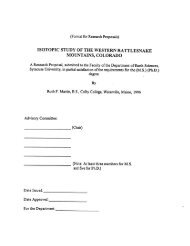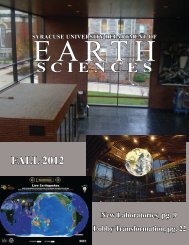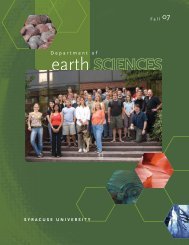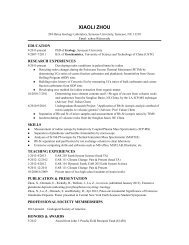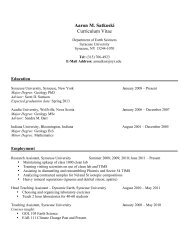alumni reception - Syracuse Universe Department of Earth Sciences ...
alumni reception - Syracuse Universe Department of Earth Sciences ...
alumni reception - Syracuse Universe Department of Earth Sciences ...
You also want an ePaper? Increase the reach of your titles
YUMPU automatically turns print PDFs into web optimized ePapers that Google loves.
from the lake and its tributary. Lake Taihu is the<br />
third largest freshwater lake in China, with an area <strong>of</strong><br />
about 2338 km 2 and a mean depth <strong>of</strong> 1.9 m, a typical<br />
shallow lake located in the delta <strong>of</strong> the Yangtze River,<br />
the most industrialized and urbanized area in China.<br />
Its main function is supplying drinking water for<br />
the surrounding cities, such as Wuxi, Suzhou, and<br />
Shanghai, but tourism, aquaculture, fisheries, and<br />
navigation are important as well. However, with the<br />
economic development and increased population in<br />
the lake basin, Lake Taihu has suffered increasingly<br />
from serious eutrophication. The main reasons for<br />
the continued deterioration <strong>of</strong> the environment <strong>of</strong><br />
Lake Taihu are increased water use and discharge;<br />
changes in agricultural practices and in fisheries and<br />
aquaculture; insufficient wastewater treatment; and an<br />
unsuitable management system.<br />
In order to figure out where the main sources<br />
<strong>of</strong> contaminants which stimulate blue algae bloom<br />
come from, we assume that different land use<br />
has a strong relationship with different halogen<br />
concentration ratios, which could be used for tracing<br />
the contamination sources. The result should have<br />
great meaning for pollution control. Also, from<br />
our water samples, after the quality monitoring is<br />
analyzed, we could get the general picture <strong>of</strong> the<br />
contamination distribution in Lake Taihu Basin which<br />
could provide necessary data information source for<br />
further research.<br />
Aleece Nanfito<br />
Last summer I spent in the field working in<br />
southwest Iceland on an enigmatic strike-slip fault<br />
zone that is parallel to the rifts. I received generous<br />
Aleece (left) in Iceland with colleague Amanda Loman.<br />
support from a John J. Prucha award, which allowed<br />
me to have a field vehicle and also purchase epoxies<br />
needed for sample collection. My master’s work is<br />
focusing on the Glufjura Fault Zone, which is a N-S<br />
oriented, right-lateral fault. The fault zone cuts through<br />
nearly flat-lying Tertiary lavas and is defined by a<br />
tabular band <strong>of</strong> highly deformed breccia and gouge.<br />
It has also been injected by almost 50 dikes that<br />
span the life <strong>of</strong> the fault. Fault-scaling relationships<br />
suggest km’s <strong>of</strong> displacement, significantly more than<br />
previously estimated. Overall, this fault is far more<br />
complex in 3-D structure than other faults in Iceland.<br />
Other rift-parallel, strike-slip faults have been noticed<br />
elsewhere in Iceland, but have not been addressed in<br />
classical interpretations <strong>of</strong> rift processes.<br />
This year I also participated in a lesson study<br />
group, which focused on updating a glaciers exercise<br />
in one <strong>of</strong> the introductory <strong>Earth</strong> Science courses.<br />
Members from the <strong>Department</strong> <strong>of</strong> <strong>Earth</strong> <strong>Sciences</strong> and<br />
the <strong>Department</strong> <strong>of</strong> Science Teaching worked together<br />
to create a lesson that was more inquiry-based and<br />
allowed the instructor to observe how the students<br />
were learning. As the new lesson was delivered,<br />
observers in the classroom collected feedback on<br />
student thought processes. With the data collected on<br />
student answers and discussion in class, the lesson<br />
can be modified to ensure the objectives <strong>of</strong> the lesson<br />
are met. The results are currently in preparation to be<br />
submitted to the Journal <strong>of</strong> Geoscience Education.<br />
Steve Riccio<br />
My advisor Paul Fitzgerald and I conducted<br />
research in the Eastern Alaska Range during June<br />
2010 near the West Fork and Susitna Glaciers, the<br />
location <strong>of</strong> 2002 Denali Fault earthquake epicenter<br />
and initial rupture zone. We sampled granitoids on<br />
the North and South <strong>of</strong> the Denali Fault, and on the<br />
hanging wall and footwall on the south-splaying<br />
Susitna Glacier thrust fault. Samples were collected<br />
in several vertical pr<strong>of</strong>iles through plutons and along<br />
a horizontal transect from the Denali fault across the<br />
Susitna fault, in order to be able to understand the<br />
exhumation patterns and relations between the two<br />
faults.<br />
I was awarded funds from the John Prucha<br />
Research Fund in May 2010, intended for our<br />
upcoming work in Alaska. The funding received was<br />
put towards helicopter time, used for supply drops,<br />
camp moves, reconnaissance, and sample collection.<br />
With the funding I received we were able to sample<br />
at a number <strong>of</strong> locations great distances along our<br />
intended horizontal transect, and move our camp to



